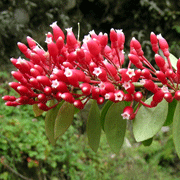James L. Luteyn and Paola Pedraza-Peñalosa
The New York Botanical Garden
THIBAUDIA
|
|
Thibaudia (Ericaceae) is a neotropical genus of ca. 60 species, ranging from Costa Rica and Panama, through the Andes from Venezuela into northern Bolivia, and eastwards through the Guianas to Brazil. |
THIBAUDIA Ruiz & Pavon ex J. St.-Hil., Expos. Fam.
1: 362. 1805; Smith, Contr. U.S. Natl. Herb. 28: 410-439.
1932; Luteyn, Fl. Ecuador 54: 290-317. 1996; Luteyn,
Fl. Venez. Guayana 4: 763-766, figs. 613-617. Lectotype: Thibaudia
mellifera Ruiz & Pavon ex J. St.-Hil.
Eurygania Klotzsch, Linnaea 24: 15, 26. 1851. Type: Eurygania parvifolia (Bentham) Klotzsch [=Thibaudia parvifolia (Bentham) Hoerold].Calopteryx A. C. Smith, J. Arnold Arbor. 27: 100. 1946. Type: Calopteryx insignis A. C. Smith.
Epiphytic or terrestrial shrubs. Leaves alternate,
evergreen; petiolate; blade coriaceous or subcoriaceous, the
margins entire or crenulate, the venation pinnate or plinerved. Inflorescence
axillary or terminal, subfasciculate, racemose or paniculate with few to
many flowers. Flowers 5-merous, without odor; aestivation valvate;
pedicels
eciduously bibracteolate; calyx articulated with the pedicel
or rarely continuous; hypanthium short-cylindric or campanulate,
wingless or occasionally narrowly 5-angled; limb erect to slightly
spreading distally; lobes triangular, subacute; corolla carnose,
subcylindric, occasionally 5-angulate, rarely weakly to strongly winged,
the lobes triangular or oblong, subacute; stamens 10, equal, often
nearly as long as the corolla, lacking spurs; filaments equal, distinct
or connate; anthers equal, basifixed, firm or membranaceous, lacking
disintegration tissue; thecae smooth or slightly granular;
tubules as long as the thecae or rarely twice as long, dehiscing by elongate
introrse clefts; pollen without viscin threads; ovary inferior;
style filiform, as long as the corolla or slightly exserted. Fruit
a berry.
Key to Neotropical Species Back to Top
A key is not currently available.
This web version has been modified from Luteyn 1996b and unpublished notes, but a treatment is still lacking.
